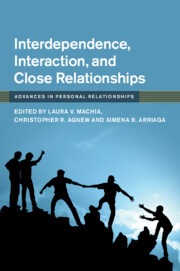Book contents
- Interdependence, Interaction, and Close Relationships
- Advances in Personal Relationships
- Interdependence, Interaction, and Close Relationships
- Copyright page
- Contents
- Figures
- Tables
- Contributors
- Acknowledgments
- Introduction
- Part I Interdependence, Situations, and Context
- Part II Interdependence, Security, and Risk
- Part III Interdependence, Goal Pursuit, and Person Factors
- Part IV Interdependence, Timing, and Expectations
- 13 Relationship Receptivity Theory
- 14 A New Measure of Expected Relationship Satisfaction, Alternatives, and Investment Supports an Expectations Model of Interdependence
- 15 Relationship Expectations about the Commitment to Wed
- 16 Creating Closeness and Interdependence
- Index
- References
14 - A New Measure of Expected Relationship Satisfaction, Alternatives, and Investment Supports an Expectations Model of Interdependence
from Part IV - Interdependence, Timing, and Expectations
Published online by Cambridge University Press: 19 June 2020
- Interdependence, Interaction, and Close Relationships
- Advances in Personal Relationships
- Interdependence, Interaction, and Close Relationships
- Copyright page
- Contents
- Figures
- Tables
- Contributors
- Acknowledgments
- Introduction
- Part I Interdependence, Situations, and Context
- Part II Interdependence, Security, and Risk
- Part III Interdependence, Goal Pursuit, and Person Factors
- Part IV Interdependence, Timing, and Expectations
- 13 Relationship Receptivity Theory
- 14 A New Measure of Expected Relationship Satisfaction, Alternatives, and Investment Supports an Expectations Model of Interdependence
- 15 Relationship Expectations about the Commitment to Wed
- 16 Creating Closeness and Interdependence
- Index
- References
Summary
Contemporary interdependence perspectives posit that intimates are more likely to remain in a relationship to the extent that they are committed to that relationship, and that they tend to be more committed to the extent that they a) are currently satisfied with the relationship, b) believe they do not currently have more desirable alternatives to the relationship, and c) have previously invested resources into the relationship. At times, though, intimates may expect that their relationship satisfaction, alternatives, and investments will increase or decrease in the future, and research on decision-making suggests that such expectations may determine their relationship commitment more than their current or past experiences do. In this chapter, we first identify factors (e.g., plans to improve the relationship, personality, gender) that may cause intimates’ expected experiences to diverge from their current experiences. Next, we review theoretical and empirical work suggesting that intimates’ relationship commitment should be determined more by their expected experiences than by their current or past experiences. Finally, we introduce a new measure of expected relationship satisfaction, alternatives, and investments designed for future research into these ideas.
- Type
- Chapter
- Information
- Interdependence, Interaction, and Close Relationships , pp. 293 - 315Publisher: Cambridge University PressPrint publication year: 2020
References
- 4
- Cited by

